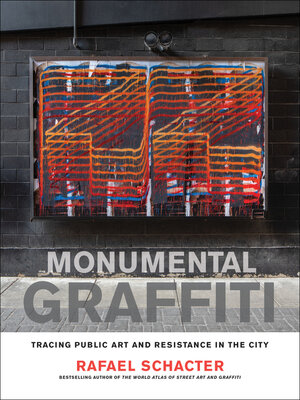
Sign up to save your library
With an OverDrive account, you can save your favorite libraries for at-a-glance information about availability. Find out more about OverDrive accounts.
Find this title in Libby, the library reading app by OverDrive.



Search for a digital library with this title
Title found at these libraries:
| Loading... |
What graffiti says about contemporary society, and why it demands our urgent attention as a form of civic expression.
What is graffiti—vandalism, ornament, art? What if, rather than any of those things, we thought of graffiti as a monument? How would that change our understanding of graffiti, and, in turn, our understanding of monument? In Monumental Graffiti, curator and anthropologist Rafael Schacter focuses on the material, communicative, and contextual aspects of these two forms of material culture to provide a timely perspective on public art, citizenship, and the city today. He applies monument as a lens to understand graffiti and graffiti as a lens to comprehend monument, challenging us to consider what the appropriate monument for our contemporary world could be.
Monumental Graffiti unpacks today’s iconoclastic moment, showing us why graffiti demands our urgent attention as a form of expression that challenges power structures by questioning whose voices are included in—and whose are excluded from—public space. Written from twenty years of embedded research on graffiti, the book includes works from graffiti writers such as 10Foot, Delta, Egs, Honet, Mosa, Petro, Revok, and Wombat, alongside those of artists such as Francis Alÿs, Jeremy Deller, Thomas Hirschhorn, Jenny Holzer, Klara Liden, Gordon Matta-Clark, William Pope.L, Cy Twombly, and many more.
Richly illustrated, this study of graffiti as monument and monument as graffiti is as fascinating as it is ethnographically expansive.
What is graffiti—vandalism, ornament, art? What if, rather than any of those things, we thought of graffiti as a monument? How would that change our understanding of graffiti, and, in turn, our understanding of monument? In Monumental Graffiti, curator and anthropologist Rafael Schacter focuses on the material, communicative, and contextual aspects of these two forms of material culture to provide a timely perspective on public art, citizenship, and the city today. He applies monument as a lens to understand graffiti and graffiti as a lens to comprehend monument, challenging us to consider what the appropriate monument for our contemporary world could be.
Monumental Graffiti unpacks today’s iconoclastic moment, showing us why graffiti demands our urgent attention as a form of expression that challenges power structures by questioning whose voices are included in—and whose are excluded from—public space. Written from twenty years of embedded research on graffiti, the book includes works from graffiti writers such as 10Foot, Delta, Egs, Honet, Mosa, Petro, Revok, and Wombat, alongside those of artists such as Francis Alÿs, Jeremy Deller, Thomas Hirschhorn, Jenny Holzer, Klara Liden, Gordon Matta-Clark, William Pope.L, Cy Twombly, and many more.
Richly illustrated, this study of graffiti as monument and monument as graffiti is as fascinating as it is ethnographically expansive.






